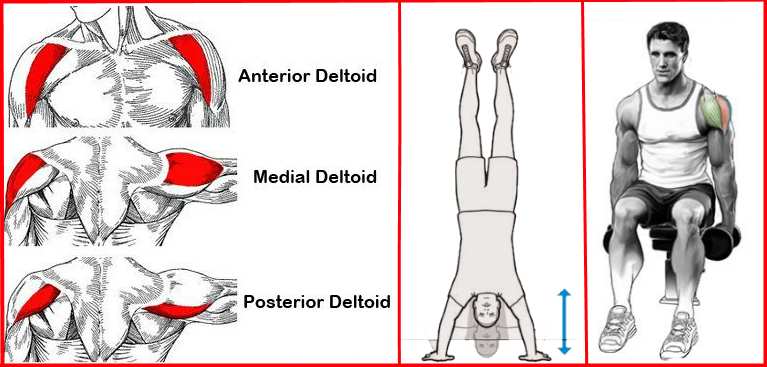You want to work out at home but are afraid you won’t be able to achieve any real shoulder progress? Worry not.
While it’s true that this task may be more difficult than working on the biceps, for example, it’s far from impossible. Actually, there are many exercises you could perform at home and are guaranteed to develop your shoulder size from tiny to cannonball!
Now, if you’re hoping to speed up the growth of any muscle group, you have to get to know its structure first, so you could understand the effects of specific movements and how to enhance them. As we’ve recently explained in another article, the shoulder is a rather unstable ball-and-socket joint, covered by a major pinnate muscle named the deltoid and its three heads:
- The anterior head, which starts on the front of the clavicle and attaches to the humerus (upper arm). It’s most important job is shoulder abduction when the shoulder is externally rotated.
- The middle head, which starts more central, i.e. on the acromion, and attaches to the outer portion of the humerus. It’s mostly involved in shoulder abduction when the shoulder is internally rotated.
- The posterior head, which starts on the back of the scapula (shoulder blade) and attaches on the humerus. It contributes to shoulder extension, external rotation and transverse abduction and extension.
Getting the shoulders into great shape involves developing all three deltoid heads, because any imbalances in this muscle group are painfully visible. Below the layer of deltoids you’ll find another muscle group called the rotator cuff, which consists of four muscles:
- Infraspinatus, a thick triangular muscle wrapped around the outside portion of the scapula.
- Teres minor, a smaller muscle found under the infraspinatus.
- Supraspinatus, a muscle that runs from the scapula to the inside of the humerus, separated from the infraspinatus by the spine of the scapula.
- Subscapularis, another large triangular muscle that originates from the subscapular fossa of the scapula and inserts in the humerus.
This muscle group is equally important as the deltoids in performing shoulder movements, but it’s even more prone to injuries due to over-training or placement of too much pressure, so it’s crucial to put some effort into strengthening it.
And a good way to prevent injury and get the most out of your shoulder workout is to always warm up before going heavy on these muscles. How?
- Cardio: 10 minutes of low intensity cardio can efficiently prepare your whole body for the following hard work.
- Windmills: place your arms out straight in front of your standing body and start rotating them in an arc for 30 seconds, then switch direction.
- Shoulder Dislocations: gruesome name for an excellent exercise for increasing flexibility in the shoulders. In a standing position, take a long stick and hold it with both hands – place them slightly wider than shoulder width. Move the stick over your head and behind it, as far as you can, while keeping the elbows straight all the time. Repeat the movement 10 times. If you feel too much tension in the shoulders, widen the grip a bit.
Now that you’re ready for some real action, check out these great exercises you can easily incorporate into your workout at home.
Bodyweight Exercises
If you can’t afford to fill your living room with gym equipment, we have some good news for you: sculpting great shoulders with the use of your bodyweight alone is more than possible. The best way to do it is by performing a circuit of exercises – this also enables you to keep burning fat all through the workout.
Here are our favorites:
Handstand Push Ups
With the help of a supporting wall, kick yourself into a handstand position. When your legs are straight with the feet resting on the wall, slowly bend the elbows and start dipping down until your head is a few inches above the ground, then push back up. If this position is too difficult for you, try a simpler variant by having your legs rest on a chair or another kind of elevated surface instead of the wall.

